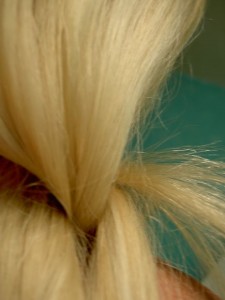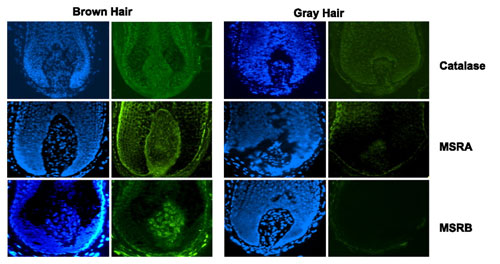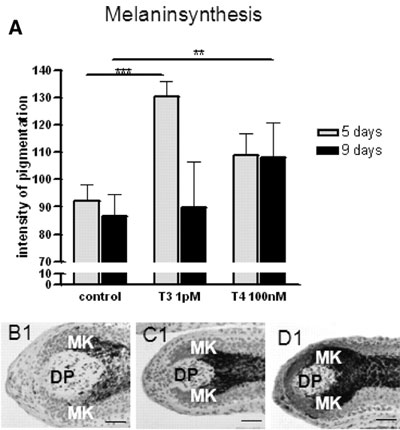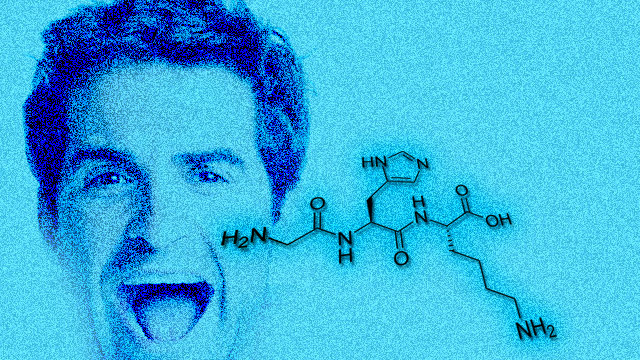If you’ve been looking into ways to treat hair loss for a while, chances are you have at least heard of "copper peptides" for hair growth. Copper peptides are the mineral copper, bonded with three protein fragments (peptides). These peptides are the amino acids alanine, histidine and lysine. Better known as copper-AHK (Cu-AHK).
The primary mechanisms are many. Its effects on growth on many types of cells, such as boosting the number (proliferation) of fibroblasts, increasing the production of vascular endothelial growth factor (VEGF), which is a substance that allows the formation of new blood vessels. Copper peptides also reduces the secretion of transforming growth factor-beta1 within the fibroblasts. Reducing this secretion is crucial to void out the negative effects of DHT. [1]
The ultimate result is less oxidative stress (free-radical attack) and a stimulation of hair growth by the dermal papilla cells. It is oxidative stress that stimulates elevated DHT formation in scalp follicles. This copper complex inhibits oxidative stress by raising the production of SOD (Superoxide dismutase), which in turn neutralizes the potent free-radical superoxide.
[1]. Arch Pharm Res. 2007 Jul;30(7):834-9.
[2]. J Pept Sci. 2012 Nov;18(11):685-90.
[3]. J Biomater Sci Polym Ed. 2008;19(8):969-88.
|
Causes of Gray Hair Discovered!
email hairsite@aol.com for details
http://www.hairsite.com/salon-news/6-gray-hair-causes.htm |
Many of us know that gray hair is due to lack of melanin, but nobody knows why melanin disappears all of a sudden, that is until now.
Scientists have recently discovered that there are four enzymes working together to cause hair to turn gray.
New discovery about the cause of gray hair was reported by the scientists and researchers at the the Universities of Bradford, Mainz and Luebeck. Details about their findings will be published in the Federation of American Societies for Experimental Biology's journal.
It was discovered that the primary or leading cause of gray hair starts with a reduction in the enzyme called catalase. Lack of catalase can result in an accumulation of hydrogen peroxide, hydrogen peroxide can in turn inhibits the production of the enzyme tyrosinase. Tyrosinase produces melanin, the hair's natural pigment.
Catalase enzymes in the body are known for their efficiency. They can break down millions of hydrogen peroxide molecules per second.
Excess hydrogen peroxide levels in the body do not only lead to graying hair. Hydrogen peroxide can also cause cell damage.
There is also a reduction of repair enzymes A and B preventing hair follicles from repairing the damage caused by the build up of hydrogen peroxide.
Research is underway to find out more about the mechanisms that lead to gray hair and possible treatment, according to one of the researchers, Karin Schallreuter, a professor of clinical and experimental dermatology at England's University of Bradford.
For those who can't wait for scientists to come up with a new product that target the lack of catalase, you may want to consider supplements that can boost catalase in our body. However, there is presently no research that suggest catalase boosting supplements can indeed reverse gray hair. Catalase is one of 4 naturally produced free-radical fighters that protect against cell damage. Catalase, along with the other 3 - superoxide dimutase, methionine reductase, and glutothione peroxidase- are all available in supplement form.
Also read article on restoring hair color using K(D)PT, a peptide that is related to Melanin Stimulating Hormone MSH.
New research finds way to restore hair colour (Hair Multiplication & Stem Cells Treatment)
http://www.hairsite.com/hair-loss/forum_entry-id-43320.html
posted by RiuraO  , Spain, 25.11.2008, 05:47
, Spain, 25.11.2008, 05:47
More of the same?
Extracted from Manchester Univ. web page. http://www.manchester.ac.uk/aboutus/news/display/?id=4162
New research finds way to restore colour to white hair following illness
13 Nov 2008
Scientists have discovered a way to potentially restore colour to white hair, new research in the British Journal of Dermatology reveals this month.
A number of skin disorders cause the hair to fall out, and when it re-grows, it is often white. For many patients, this is almost as distressing as the initial hair loss.
Melanin, the pigment in skin and hair, is stimulated by a group of peptide hormones collectively known as ‘melanocyte stimulating hormone’ or MSH.
Researchers at The University of Manchester and in Germany therefore examined whether a peptide called K(D)PT, which can be synthetically produced in the laboratory and is related to MSH, might have the same pigmentation stimulating effects as the naturally occurring MSH, and whether this could be used to restore colour to white hair after illness.
The team treated normal, isolated hair follicles from six women aged between 46 and 65 with different concentrations of K(D)PT. The research was carried out in the laboratory as it is not yet ready for direct use on patients.
In some of the test groups, the follicles were first treated with ‘Interferon type II’, commonly known as IFN-y, a proinflammatory stimulus that is linked to certain autoimmune disorders. The purpose of this was to mimic the sort of inflammation that is present in disorders that cause the hair to fall out, including ‘alopecia areata’, a skin disease that causes hair loss, and ‘telogen effluvium’, a disorder that causes thinning of the hair, often after an accident, illness or extreme stress on the body.
Hair frequently loses colour after this sort of inflammation, so that when the hair returns, it is often white, regardless of its colour prior to hair loss.
The test groups were either pre-treated with IFN-g then given K(D)PT, pre-treated with K(D)PT then IFN-y, treated with K(D)PT alone, treated with IFN-y alone, or in the case of the control group, treated with distilled water.
The study found that K(D)PT increased the amount of melanin (pigment) in the hair follicle significantly when administered after pre-treatment with IFN-y.
This pre-treatment with a proinflammatory stimulus appeared to be necessary for the pigment effect to occur, as it was absent in the group where K(D)PT was administered first and IFN-g second. Likewise, IFN-y alone inhibited rather than stimulated pigment production, and K(D)PT used alone did not significantly alter the hair pigmentation. It is thought that as yet unknown receptors for K(D)PT are elevated or present only in tissue inflamed by substantial IFN-y activity.
As the purpose of pre-treating with IFN-y was to mimic the sort of inflammatory changes that may contribute to hair turning white, to then see whether K(D)PT could restore the hair colour, these findings are of particular use to the treatment of hair that has turned white following illness.
The study’s senior author Dr Ralf Paus, of the University of Lübeck, Germany, and the School of Translational Medicine at the University of Manchester, said: "Since this tripeptide displays interesting hair pigmentation-stimulatory activities under proinflammatory conditions, clinically, K(D)PT deserves to be explored as an innovative new anti-greying agent.
"Specifically, topical application of K(D)PT may become exploitable for the treatment of postinflammatory hair whitening that is often seen during the recovery phase of alopecia areata."
Nina Goad of the British Association of Dermatologists said: "It’s important to note that this is laboratory research and not yet ready for use on patients. However, while the research is still at a very early stage, these findings could potentially pave the way for new therapies that restore colour to white hair. At the moment, this research only applies to people whose hair has turned white following illness, but this is an important step for such patients."
At this early preclinical stage, it is not possible to say for definite if it would restore hair to its full, original colour, although this is thought to be a reasonable possibility. However, there may indeed be patients whose hair follicle pigmentary system has been damaged beyond repair, who might not profit at all from such a treatment. Most likely, treatment would have to be re-administered, as long as the pro-inflammatory stimulus that caused hair whitening persists.
Ends
Notes for editors
It is not possible to say whether the results could also apply to chemotherapy patients, since no chemotherapeutic agent was tested in these currently reported preclinical assays.
Articles in the BJD can be viewed online: http://www3.interscience.wiley.com/journal/117983344/home
Study details: British Journal of Dermatology, DOI 10.1111/j.1365-2133.2008.08872.x, The a-melanocyte stimulating hormone-related tripeptide K(D)PT stimulates human hair follicle pigmentation in situ under proinflammatory conditions; K.C. Meyer*; T. Brzoska ²,³; C. Abels² and R. Paus*§
*Department of Dermatology, University of Lübeck, Ratzeburger Allee 160, D-23538 Lübeck, Germany
²Wolff Arzneimittel, Bielefeld, Germany
³Department of Dermatology, University of Münster, Münster, Germany
§School of Translational Medicine, University of Manchester, Manchester, U.K.
The British Association of Dermatologists is the central association of practising UK dermatologists. Our aim is to continually improve the treatment and understanding of skin disease.
For further information contact:
Nina Goad
British Association of Dermatologists
Communications Manager
Tel: 0207 391 6355
Email: nina@bad.org.uk
Website: www.bad.org.uk
TRX2 Active Ingredients & Research Studies: TRX2’s active ingredients and mechanism of action on potassium ion channels are well documented. Below please find a selection of the relevant peer reviewed scientific publications.
L-carnitine-L-tartrate promotes human hair growth in vitro.
AUTHOR:
Foitzik K, Hoting E, Förster T, Pertile P, Paus R.
JOURNAL
Exp Dermatol. 2007 Nov;16(11):936-45.
ABSTRACT
The trimethylated amino acid l-carnitine plays a key role in the intramitochondrial transport of fatty acids for beta-oxidation and thus serves important functions in energy metabolism. Here, we have tested the hypothesis that l-carnitine, a frequently employed dietary supplement, may also stimulate hair growth by increasing energy supply to the massively proliferating and energy-consuming anagen hair matrix. Hair follicles (HFs) in the anagen VI stage of the hair cycle were cultured in the presence of 0.5-50 microm of l-carnitine-l-tartrate (CT) for 9 days. At day 9, HFs treated with 5 microm or 0.5 microm of CT showed a moderate, but significant stimulation of hair shaft elongation compared with vehicle-treated controls (P < 0.05). Also, CT prolonged the duration of anagen VI, down regulated apoptosis (as measured by TUNEL assay) and up regulated proliferation (as measured by Ki67 immunohistology) of hair matrix keratinocytes (P < 0.5). By immunohistology, intrafollicular immunoreactivity for TGFbeta2, a key catagen-promoting growth factor, in the dermal papilla and TGF-beta II receptor protein in the outer root sheath and dermal papilla was down regulated. As shown by caspase activity assay, caspase 3 and 7, which are known to initiate apoptosis, are down regulated at day 2 and day 4 after treatment of HFs with CT compared with vehicle-treated control indicating that CT has an immediate protective effect on HFs to undergo programmed cell death. Our findings suggest that l-carnitine stimulates human scalp hair growth by up regulation of proliferation and down regulation of apoptosis in follicular keratinocytes in vitro. They further encourage one to explore topical and nutraceutical administration of l-carnitine as a well-tolerated, relatively safe adjuvant treatment in the management of androgenetic alopecia and other forms of hair loss.
Novel and established potassium channel openers stimulate hair growth in vitro: implications for their modes of action in hair follicles.
http://www.hairsite.com/hair-loss-treatment/trx2/trx2-ingredients-research-studies.htm
http://www.hairsite.com/hair-loss/forum-category-18.html
Can a supplement reverse graying hair?
Product's claim is 'hypothetical,' one expert says
http://articles.chicagotribune.com/2013-05-08/health/sc-health-0508-gray-hair-20130508_1_gray-hair-healthy-hair-hydrogen-peroxide
May 08, 2013/By Alexia Elejalde-Ruiz, Tribune Newspapers
During her post-divorce reinvention, Judy Allor decided to do something about the gray hair that had been coming in at her temples and around her ears since her early 50s. Highlights didn't seem to take - so when Allor saw an advertisement in SkyMall magazine for a nutritional supplement that promised to stop the gray, she put in an order.
Within three months of taking two pills a day of Go Away Gray, Allor said she started noticing her natural light blond color replacing the gray spots. She said her hair felt as soft and silky as it had when she was younger, and her trips to the salon for highlights became fewer and further between.
"I call it vitamins for my hair," said Allor, a retiree who splits her time between Florida and California.
Go Away Gray, a nutraceutical without FDA approval or any clinical trials supporting its effectiveness, is among several products being marketed to prevent gray hair.
Creator Cathy Beggan, a former real estate agent whose company, Rise-n-Shine LLC, sells 17 products promising help for everything from wrinkles to joint pain, said Go Away Gray is by far her company's biggest seller (buy two bottles and get one free for $49.50). She points to customers like Allor as proof that it works, and claims that within six to eight weeks customers can see their natural hair color coming in at the root (it doesn't change existing gray hair).
But is that proof enough?
A closer look
Dr. Gerard Mullin, associate professor of medicine at Johns Hopkins University School of Medicine and author of the book "The Inside Track: Your Good Gut Guide to Great Digestive Health," cautions people to save their money.
"There's been no credible research to validate their claim," he said. "What they're claiming is very hypothetical."
Beggan created Go Away Gray in 2009 after coming across a study by researchers at the University of Bradford, in the United Kingdom, that found that reduced production of the enzyme catalase, which breaks down hydrogen peroxide, may contribute to graying hair. Hair cells naturally produce small amounts of hydrogen peroxide, but without catalase it builds up over time and blocks the normal synthesis of melanin that gives hair its color, according to the study, which was published in The FASEB Journal (it stands for Federation of American Societies for Experimental Biology).
Beggan contracted with a vitamin manufacturer to produce a supplement containing 5,000 units of catalase plus other ingredients believed to promote healthy hair.
Mullin said the ingredients at the doses recommended are harmless. But "there is no proof whatsoever" that catalase ingested orally can survive the gastrointestinal process and affect the hair follicle. For those wishing to give it a shot, it would be cheaper to eat a bowl of catalase-rich blueberries, blackberries or radishes, he added.
Beggan said several overseas companies that wish to distribute the product require clinical trials, which she said are currently underway.
Catalase-based products aren't the only ones touting anti-gray cures. L'Oreal has been researching a fruit extract that mimics the enzyme TRP-2, which helps make pigment-producing cells called melanocytes, and several media outlets reported the cosmetics company is working on a pill with an anticipated 2015 launch.
Three-quarters of people 45 to 65 have gray hair, according to a study published last year in the British Journal of Dermatology.
A Pill To Prevent Gray Hair - Is It Finally On The Way?

Rapunzel tresses forever are finally a possiblity (photo: Morguefile)
In the past three years, the concept of popping a pill to prevent gray hair has been fast-tracked from fantasyland to almost-reality. First came the groundbreaking British study published by FASEB (the Federation of American Societies for Experimental Biology) in 2009 exposing the mechanism that governs loss of hair pigment.
Researchers at the University of Bradford in the UK demonstrated how over time, accumulated oxidative stress leads to the overproduction of hydrogen peroxide in the hair follicles. In other words, the hair begins to bleach itself from the inside out. The buildup of hydrogen peroxide begins to block the production of melanin, the pigment that gives hair its blonde, red or brown color.
Underlying this process is a series of complex chemical mechanisms involving the effects of oxidative stress and follicle damage on key enzymes. One is catalase, which is supposed to break up the hydrogen peroxide into water and oxygen so the body can eliminate it. But catalase levels drop as we age, allowing hydrogen peroxide to accumulate unchecked.

Would Emmylou Harris have taken a pill to prevent gray hair? Would you? (photos: public domain; collage: Melanie Haiken)
Two other enzymes, known as MSR A and B, are supposed to stimulate hair follicles to repair the damage, but levels of MSR A and B drop with age as well. Without enough MSR A and B, the body can’t produce enough of another enzyme, tyrosinase, which is directly involved in melanin production.
A New Consumer Market: Gray Hair Prevention
All of these enzymes give drugmakers new targets for medications and supplements aimed at boosting levels of catalase, MSR A and B, and tyrosinase. Cue the rush to market.
One such drug has already been announced by L’Oreal, which promises a 2015 market launch. A fruit extract about which little else is known, L’Oreal’s product acts on the production of tyrosine-related protein TRP-2. Of course, there’s no need to point out that a no-gray-hair pill could make L’Oreal a great deal of money. L’Oreal researcher Bruno Bernard was quoted by the Christian Science Monitor as saying the company already has a "watertight proof of concept" and will be in full production by 2015.
Smaller companies and supplement manufacturers aren’t waiting in the wings, though. They’re mounting online sales campaigns and putting new products on health food store shelves everyday.
The best known of these, having mounted an impressive viral marketing campaign, is Go Away Grey, manufactured by Rise-N-Shine LLC of New Jersey. Go Away Grey, which has been covered in a plethora of women’s magazines and newspapers, contains 5000 IU of catalase and a cocktail of L-tyrosine and tyrosine-boosting plant extracts, with the promise that boosting catalase and tyrosinase levels will prevent graying.
More catalase-based supplements are arriving everyday. Other contenders include Anti-Gray Hair 7050, No More Gray with Catalase, and Anti Grey Pure by Absonutrix.
Do they work? Hard to say. The road is littered with discarded vitamins and minerals that made perfect sense but proved to be digested and excreted without effect. Some experts have suggested that it may be more effective to supplement the minerals such as zinc and selenium that the body uses to produce catalase, MSR A and B, and tyrosinase, rather than take them directly. Spinach, avocados, and liver are rich in catalase, so you could always try adding these to your diet for a more natural approach.
Next Step: Risk Warnings from Docs
Of course, we’re talking about important enzymatic reactions here, and doctors immediately reacted to the L’Oreal announcement by cautioning that there may besignificant risks to meddling with basic biology in this way. Without a product available from L’Oreal to test, however, it’s hard to argue for or against health concerns. One would hope that the anti-gray supplements already on the market have been proven safe. But there’s no way of knowing that, either. Supplements are not subject to the same regulatory scrutiny by the FDA that new drugs must undergo.
Don’t Throw Away Your Hair Dye Yet
Unfortunately, if you’re already gray or quickly getting there, the new pills won’t help you much. They have the potential to stop the graying process, but so far no one’s suggested any ability to reverse it. In fact, L’Oreal’s Bruno Bernard specifically warned that people will likely need to begin taking L’Oreal’s new supplement well before (as much as ten years before!) they would expect to begin turning gray to see the full effects.
Follow me on Twitter, @MelanieHaiken or subscribe to my posts on Facebook
http://www.forbes.com/sites/melaniehaiken/2013/02/28/a-pill-to-prevent-gray-hair-is-it-finally-on-the-way/







